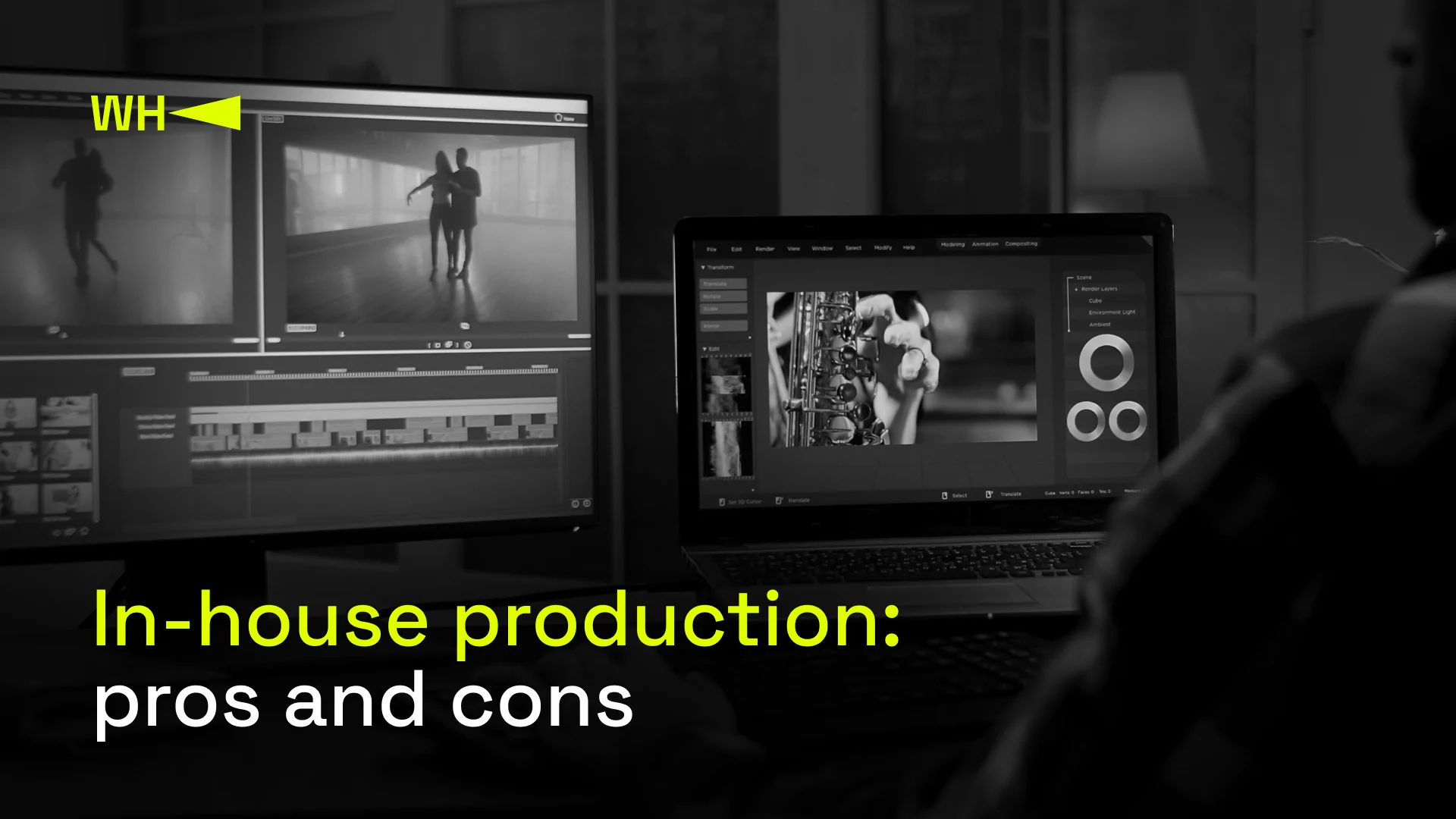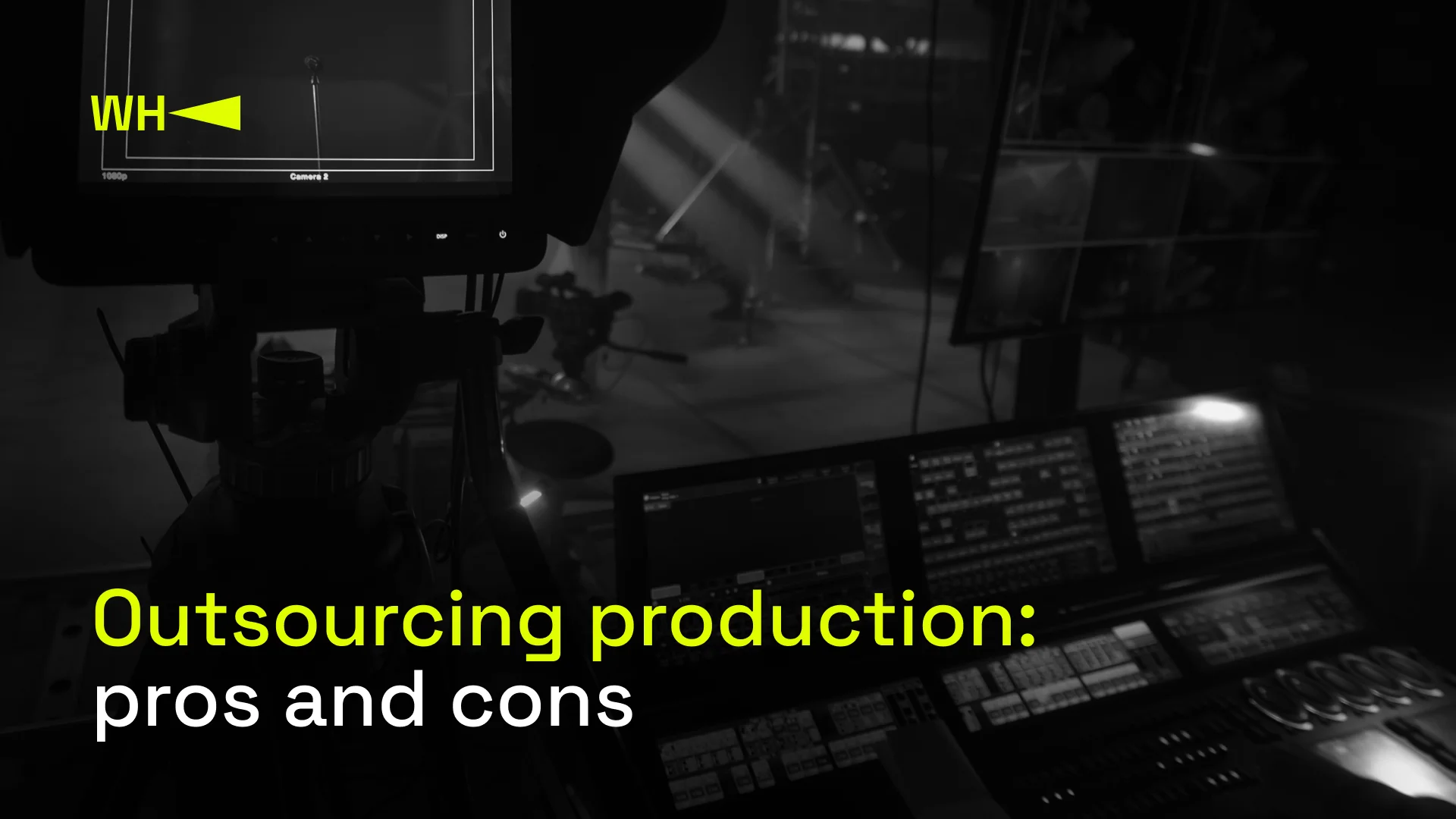Feb. 23, 2024
Video Outsourcing or In-House Production: How To Know What’s Right for You

6 min read
With video content becoming commonplace, more and more companies are trying to create teasers, films, TV shows, or run YouTube channels for their brand. At that point, they all face the choice of creating content on their own or turning to outsourcing. There are solutions to suit any business, and this article is meant to help you compare the pros and cons of each option to find the video creation method that best fits your needs.
Video production process
Let’s start by clarifying what the process of creating a video includes. Making a video, be it a teaser or a film, is a complex process that requires a whole multi-skilled team.
Defining the concept
It all starts with small steps like setting goals, discussing ideas, etc. Nothing out of the ordinary, right? However, during this stage, it’s important to stay unbiased and consider each idea carefully before throwing any of them away.
Story and script
Once the idea is clear, the video production team has to get into details. They must describe each scene of the future video and write a script to create the exact story the client wants to tell.
Venue and setup
Finding the right location is challenging, but all the efforts will pay off during setup. A location with poor ventilation, low ceilings, and other restrictions makes filming possible but quite tricky. Sometimes, companies partner with construction industry professionals to set up the backdrop to the desired standards.
Filming and production
Once the equipment is installed, lighting is set up, and cameras are in the right positions, filming can start. It is a complex stage where all process components must work together as a well-oiled mechanism, following quality control rules. The video will only work out with all the ingredients in place, from cameras to lighting.
Other stages
Each video has its own specific requirements. For example, some content, especially long-form, such as livestreamed events, requires the work of AR or computer graphics specialists, etc. Meanwhile, raw footage tends to need editing, like correcting the sound or making tech changes.
In-house production: pros and cons
In-house production refers to internal, aka in-house, manufacturing, where your staff specialists cover most parts of the process. To create video content on its own, a company needs a team of professionals who will work exclusively on a specific product. You should weigh the pros and cons carefully before deciding to produce in-house.
Domain knowledge
Getting to know a company in detail takes time, but the in-house production crew is already in the loop. A detailed portrait of the target audience, their pain points and goals — this information is a must if you want to create a valuable video that will meet the audience’s needs.
Production and quality control
When using its own team, the client has complete control over the process. The company can monitor and manage every detail and stay on top of organizational issues. Production schedules can be conveniently adjusted without a time-consuming approval process.
High upfront costs: set and equipment rental
To build your in-house production capabilities, you need an initial investment. Equipment for stage settings and filming is quite expensive, so companies often prefer to use equipment rental and staging rental gear. However, this cost-saving method is not suitable for every case. If a company is determined to deliver video content on an ongoing basis, some gear needs to be purchased so that it is always at hand to avoid equipment rental delays.
Outsourcing production: pros and cons
While outsourcing production means you relinquish some control, as compared to in-house production, it has its own advantages.
Production capacity
More resources are needed to generate more video content. If you do it in-house, your company’s ability is quite limited, and you will need to expand it by renting equipment or studios. This is a labor-intensive and lengthy process that can take up precious time and keep your specialists away from other tasks. Outsourcing solves the scalability problem and offers hands-on solutions to increase production capacity. Yes, outsourcing companies also often use rental gear, but most of the equipment is already there, unlike production in-house.
Expertise and knowledge
While you know everything about the product, the video company knows everything about filming. The production studio is responsible for critical strategic decisions such as location, equipment, and even color and shares its expertise with you. Plus, by outsourcing production, you get an unbiased perspective, which is not the case with in-house production. A crew that has just found out about your products can be an excellent focus group to highlight their strengths and offer out-of-the-box solutions for filming. The production team’s expertise can extend to other fields, such as intellectual property law. A company that has been working with creative solutions for a long time can tell you how to protect yourself from intellectual property theft since this is also in their interests.
Lack of control
Although the outsourcing studio aligns its vision with the customer’s, brand representatives don’t have direct control over the filming process, unlike in-house production. This is not necessarily a disadvantage because, when delegation is done right, directly managing a process is optional. However, it all depends on how well you choose a partner. An experienced production company or agency will take the time to determine your expectations and how to meet demand. At the same time, the wrong choice of a partner will help you record fantastic video content that does nothing to bring you closer to your goal.
What to choose?
Deciding between in-house and outsourcing is a critical strategic choice for a company, and there is no single answer because different options suit different cases. For example, if a company is planning a large, long-term project like a TV show, it is better to turn to an outsourcer who, with their knowledge, will help produce suitable content. However, if a company plans on creating a lot of small-form content, for example, for social media, it is something they can manufacture in-house.
It is not uncommon for a company to use a hybrid model, where the in-house production team is responsible for part of the content while the rest is outsourced. This approach can both help distribute the load effectively and guarantee a certain volume of work for staff specialists.
Even smaller companies can make how-to guides, customer testimonials, social media videos, and video explainers on their own. These may not be fully polished, but their authenticity is an advantage in and of itself.
At the same time, outsourcing may be used for larger video projects, such as virtual events, films about the company, and advertising campaigns. This is the type of video that is not required every day. Still, preparation, storyboarding, and equipment setup are fundamental, so the expert assistance of a production team in this case will definitely prove invaluable.


